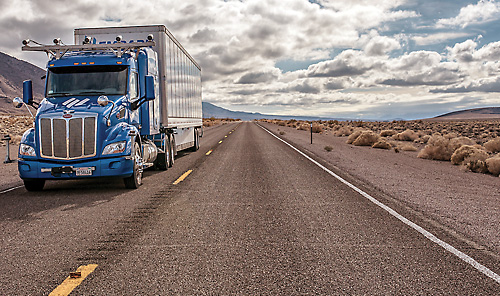Front Line: A New Age for Trucking
High driver turnover, the new mandate limiting drivers’ hours on the road, and the boom in e-commerce are spurring the adoption of driverless trucks.
Q1 2018

There are many reasons for the shortage: age, gender inequality, lifestyle issues, long hours away from home, cost of obtaining a commercial driver’s license, and mounting regulations. Drivers are restricted by law from driving more than 11 hours per day without taking an eight-hour break. To stop the cheaters, a mandate when into effect December 18 under the Federal Motor Carrier Safety Administration (FMCSA) that requires truck operators to use electronic logging devices (ELDs) to keep records of duty status.
For asset-based companies and those that purchase trucking services, capacity and a severe shortage of truck drivers is the “elephant in the room,” comments Matt Luckas, vice president of Supply Chain Services for Hanson Logistics. “Driver shortages across the board are impacting all facets of trucking,” he says.
Meanwhile, the American Trucking Associations’ (ATA) data indicates that since the Great Recession, freight volumes have been going through the roof. For 2017, ATA’s seasonally adjusted (SA) For-Hire Truck Tonnage Index was up 3.7 percent from 2016 — the largest annual gain since 2013 (6.1 percent). The Association estimates that more than 3.4 million heavy-duty Class 8 trucks and over 3.5 million truck drivers are required to move 10.5 billion tons of freight annually.
Yet, Bob Costello, ATA’s chief economist, reports that annualized driver turnover rates have recently been as high as 95 percent. He notes that the shortage falls between 35,000 and 40,000 drivers. Then there are added factors, notably the boom in e-commerce and the need for quick deliveries.
New Age
“Same day delivery is evolving into same-hour delivery in some places, and consumers are insisting on a broader selection and availability of goods,” observes Dan Letter, managing director of Capital Deployment NW Region for Prologis, a multination logistics real estate investment trust.
A report by The Center for Technology Innovation at the Brookings Institute attributes the boom in e-commerce will lead to trucks quickly adopting autonomous vehicles. A number of companies, including Daimler and Volvo, are working on driverless truck adoption. They’ve made test runs in Europe.
Same day delivery is evolving into same-hour delivery in some places, and consumers are insisting on a broader selection and availability of goods. Dan Letter, managing director, Capital Deployment NW Region, Prologis In the U.S., Embark Trucks — with partners Ryder and Electrolux (which operates the Frigidaire Line) — has been running the longest autonomous route in the world — 650 miles starting in Texas and ending in California. And, in early February, Embark completed a cross-country test drive from Los Angeles to Jacksonville, Florida. San Francisco start-up Embark relies on Ryder’s trucks and drivers to ferry freight between the warehouse and the interstate. “Embark’s trucks pick up at the edge of the interstate, and from there the computer drives [the truck] 650 miles,” a company video explains.
Embark doesn’t manufacturer trucks, but integrates autonomous technology into Peterbilt semis. That technology uses machine learning software and data from the sensors on board the truck to map its surroundings in real time and avoid obstacles.
The potential is huge. Market intelligence firm Tractica sees market growth accelerating as successful pilot projects come at an increasing pace. In fact, Tractica estimates that worldwide revenue from autonomous trucks and buses reached $84 million in 2017. It expects that with more competition within the industry, providing significant opportunities to various industry participants, the market will reach a value of $35 billion by end of 2022. During that period, Tractica forecasts that annual unit shipments will increase from approximately 343 vehicles in 2017 to 188,000 units in 2022.
While there still may be some resistance, autonomous trucks may provide a solution to today’s driver shortage and other issues.
Project Announcements
SLB Expands Shreveport, Louisiana, Operations
12/18/2025
Eastover Chips Plans Eastover, South Carolina, Wood Chipping Operations
12/18/2025
Eli Lilly and Company Plans Huntsville, Alabama, Manufacturing Operations
12/18/2025
Eccalon Plans Detroit, Michigan, Headquarters Operations
12/18/2025
AECI Utility Solutions Plans Boonville, Missouri, Distribution Operations
12/18/2025
DrinkPak Plans Philadelphia, Pennsylvania, Manufacturing Operations
12/18/2025
Most Read
-
The Workforce Bottleneck in America’s Manufacturing Revival
Q4 2025
-
Rethinking Local Governments Through Consolidation and Choice
Q3 2025
-
Lead with Facts, Land the Deal
Q3 2025
-
Investors Seek Shelter in Food-Focused Real Estate
Q3 2025
-
America’s Aerospace Reboot
Q3 2025
-
The Permit Puzzle and the Path to Groundbreaking
Q3 2025
-
Supply Chain Whiplash Reshapes CRE
Q3 2025



